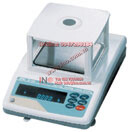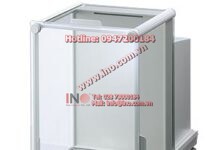Model 7124 – Overview
Since their invention back in the 1960's, lock-in amplifiers have been used whenever the need arises to measure the amplitude and/or phase of a signal of known frequency in the presence of noise. Unlike other AC measuring instruments they have the ability to give accurate results even when the noise is much larger than the signal – in favorable conditions even up to a million times larger.
Early instruments used analog technology, with manual controls and switches, and with output readings being taken from large panel meters. Later, microprocessors were added to give more user-friendly operation, digital output displays, and to support computer control. More recently the analog phase sensitive detectors forming the heart of the instrument have been replaced by DSP (digital signal processing) designs, further improving performance.
But the addition of this digital technology has had one unfortunate side effect, which is that the instrument itself can act as a source of digital clock and switching noise, which is typically coupled back into the experiment via the signal or internal oscillator connectors. This noise is of course rejected by the lock-in and generally does not impair its performance, but the power it dissipates in the sample or device under test can cause serious problems. This is particularly the case in low temperature physics experiments.
SIGNAL RECOVERY is therefore proud to introduce the model 7124 precision lock-in amplifier, which is particularly suited to such work. It uses a unique analog fiber optic link to interconnect a remote connection unit (RCU), to which the experiment is connected, and a main instrument console. In normal operation there are no digital clock signals within the RCU, and so it can emit no switching noise.
This architecture gives an instrument with all the advantages of the latest DSP technology for signal detection, and a powerful processor for easy user operation, as well as the low noise performance that until now has only be available in instruments of all-analog design.
Signal and Reference Connections
In normal use the 7124's signal and reference connections are made at the RCU. The signal input can be switched to operate in single ended or differential voltage mode, or in current mode with a choice of two transimpedance settings. It can also be used to switch between two single-ended voltage signals, for simple sequential measurement, under computer control, of two inputs. In cases where further preamplification is needed then one of the SIGNAL RECOVERY remote preamplifiers can be used, with its output connected to the 7124's single ended voltage input. This flexible choice of input modes allows the best possible connection to be made to the experiment. The RCU also has both general purpose analog and TTL logic reference inputs, as well as the output for a precision DDS oscillator that generates a sinewave signal of adjustable frequency and amplitude.
The RCU is connected to the main instrument console via a 16ft (5 m) fiber cable bundle that carries the applied signal and oscillator outputs in analog form, and control signals to the RCU and the reference signal from it, in digital format. However, the RCU contains no digital clocks or oscillators that are running continuously, and so unlike all other lock-in amplifiers that use any form of logic control, there is no digital switch noise present at the signal connectors.
- No digital clock or switching noise present at the RCU connectors
- 0.5 Hz to 150 kHz operating frequency range
- Voltage and current mode inputs
- 1.0 MHz main ADC sampling rate
- 10 µs to 100 ks output filter time constants
- Dual Reference, Dual Harmonic and Virtual Reference operating modes
- USB, RS232, and Ethernet computer interfaces
Since their invention back n the 1960's, lock-in amplifiers have been used whenever the need arises to measure the amplitude and/or phase of a signal of known frequency in the presence of noise.
Model 7124 Specifications
| Signal Channel – Remote Connection Unit (7124RCU) | |
| Voltage Input | |
| Modes | A only, -B only or Differential (A-B) |
| Frequency Response | 0.5 Hz < F < 150 kHz (–3dB) |
| Full-scale Sensitivity | 2 nV to 1 V in a 1-2-5 sequence (e.g. 2 nV, 5 nV, 10 nV, 20 nV, etc.) |
| Impedance – FET input | 10 MΩ // 25 pF, AC or DC coupled |
| Indepance – Bipolar input | 10 kΩ // 25 pF, input must be DC coupled |
| Max safe input | ±12.0 V |
| Voltage Noise | 5 nV/√Hz @ 1 kHz |
| C.M.R.R. | > 100 dB @ 1 kHz degrading by no more than 6 dB/octave with increasing frequency |
| Gain Accuracy | ±1.0% typ, ±2.0% max |
| Distortion | -90 dB THD (60 dB AC gain, 1 kHz) |
| Current Input | |
| Mode | Low Noise (10E8 V/A) or Wide Bandwidth (10E6 V/A) |
| Full-scale Sensitivity | |
| Low Noise | 2 fA to 10 nA in a 1-2-5 sequence |
| Wide Bandwidth | 2 fA to 1 µA in a 1-2-5 sequence |
| Frequency Response (-3 dB): | |
| Low Noise | 0.5 Hz < F < 500 Hz minimum |
| Wide Bandwidth | 0.5 Hz < F < 50 kHz minimum |
| Impedance | |
| Low Noise | < 2.5 kΩ @ 100 Hz |
| Wide Bandwidth | < 250 Ω @ 1 kHz |
| Noise | |
| Low Noise | 13 fA/√Hz @ 500 Hz |
| Wide Bandwidth | 130 fA/√Hz @ 1 kHz |
| Gain Accuracy | ±2.0% typ, midband |
| Either Input Mode | |
| Line Filter | Filter can be set to attenuate 50/60 Hz, 100/120 Hz, or both frequency bands |
| Max. Dynamic Reserve | > 100 dB |
| Grounding | BNC shield can be grounded or floated via 1 kΩ to ground |
| Signal Monitor Amplitude | ±1 V FS. This is the signal after preamplification and filtering, but before transmission over the optical link |
| Output Impedance | 1 kΩ |
| Signal Channel – Main Console | |
| Auxiliary Input | |
| Mode | Single-ended voltage mode input |
| Impedance | 10 MΩ // 25 pF |
| Maximum Safe Input | ±12.0 V |
| Full-scale | 1 V |
| Sensitivity | |
| Signal Monitor Amplitude | ±1 V FS. This is the signal received from the Remote Connection Unit immediately prior to conversion by the main ADC |
| Output Impedance | 1 kΩ |
| Reference Channel | |
| Reference Input – Remote Connection Unit or Main Console | |
| TTL Input (rear panel) | |
| Frequency Range | 0.5 Hz to 150 kHz |
| Analog Input (front panel) | |
| Impedance | 1 MΩ // 30 pF |
| Sinusoidal Input Level | 1.0 V rms* |
| Frequency Range | 0.5 Hz to 150 kHz |
| Squarewave Input Level | 250 mV rms |
| Frequency Range | 2 Hz to 150 kHz |
| Reference Channel | |
| Phase Set Resolution | 0.001° increments |
| Phase Noise at 100 ms TC, 12 dB/octave slope: | |
| Internal Reference | < 0.0001° rms |
| External Reference | < 0.01° rms @ 1 kHz |
| Orthogonality | 90° ± 0.0001° |
| Acquisition Time | |
| Internal Reference | instantaneous acquisition |
| External Reference | 2 cycles + 1 s |
| Reference Frequency Meter Resolution | 4 ppm or 1 mHz, whichever is the greater |
| Demodulator and Output Processing | |
| Output Zero Stability | |
| Digital Outputs | No zero drift on all settings |
| Displays | No zero drift on all settings |
| DAC Analog Outputs | < 100 ppm/°C |
| Harmonic Rejection | -90 dB |
| Output Filters | |
| Time Constant | 10 µs to 100 ks in a 1-2-5 sequence |
| Slope (roll-off): | |
| TC < 5 ms | 6 or 12 dB/octave |
| TC > 5 ms | 6, 12, 18 or 24 dB/octave |
| Synchronous Filter | Available for F < 20 Hz |
| Offset | Auto and Manual on X and/or Y: ±300% full-scale |
| Phase Measurement Resolution | < 0.01º |
| Reference Monitor | TTL signal at current reference frequency, internal or external |
| Oscillator – General | |
| Frequency | |
| Range | 0.5 Hz to 150 kHz |
| Setting Resolution | 1 mHz |
| Absolute Accuracy | ± 50 ppm |
| Amplitude | |
| Range | 1 mV to 5 V |
| Setting Resolution | 1 mV |
| Output Impedance | 50 Ω |
| Sweep | |
| Frequency Sweep | |
| Output Range | 0.5 Hz to 150 kHz |
| Law | Linear or Logarithmic |
| Step Rate | 1 kHz maximum (1 ms/step) |
| Amplitude Sweep | |
| Output Range | 0.000 to 1.000 V rms |
| Law | Linear |
| Step Rate | |
| Main Console | 20 Hz maximum (50 ms/step) |
| RCU | 1 Hz maximum (1 s/step) |
| Oscillator Output – Remote Connection Unit | |
| Amplitude | |
| Accuracy | ±1.0% typ |
| Stability | 100 ppm/ºC |
| Distortion (THD) | -80 dB @ 1 kHz and 100 mV rms |
| Oscillator Output – Main Console | |
| Amplitude | |
| Accuracy | ±0.2% typ |
| Stability | 50 ppm/ºC |
| Distortion (THD) | -80 dB @ 1 kHz and 100 mV rms |
| Data Storage Buffer | |
| Size | 100,000 data points |
| Max. Storage Rate | |
| Fast Mode | up to 1 MHz (X1, Y1, X2, Y2, ADC1, Demod I/P 1, Demod I/P 2) |
| General | ||
| Main Console | 7124 RCU | |
| Power Requirements | ||
| Voltage | 110/120/220/240 VAC | 110/120/220/240 VAC |
| Frequency | 50/60 Hz | 50/60 Hz |
| Power | 40 VA max |
Resource & DownloadLưu ý: Nếu một thiết bị nào đó không được liệt kê ở đây, điều đó không có nghĩa rằng chúng tôi không hỗ trợ được bạn về thiết bị đó. Hãy liên hệ với chúng tôi để biết danh sách đầy đủ về thiết bị mà chúng tôi có thể hỗ trợ và cung cấp.
INO: Bán, Báo giá, tư vấn mua sắm và cung cấp, tư vấn sản phẩm thay thế; tương đương, hướng dẫn sử dụng, giá…VNĐ, …USD info@ino.com.vn | Tel: (+84) 028 73000184 | Signal Recovery- Dual Phase Lock-in Amplifier (Model 7124).
|




















